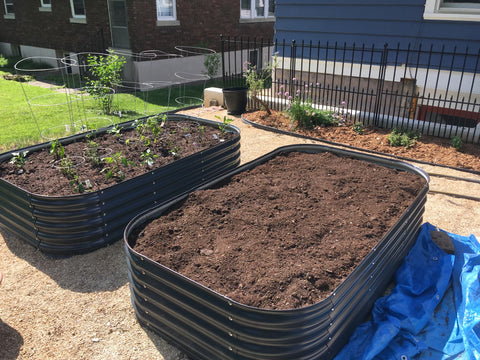Tips from Olle Garden Bed: Why Should You Mulch
Learn more about one of the best things you can do for your garden: mulch it!
Of course, adding mulch to your garden and landscape will make your plants look great (even beautiful colors can be added), but it also brings many great things to plants and soil. This is why mulch can be considered the gardener's best friend.The following content also has some reference value for raised garden beds.

You must cut down on weeding. When you mulch the soil with mulch, the sun cannot shine on the weed seeds, so many will not germinate. Weeds blown in and deposited in the mulch may germinate, but they will be easier to pull out.
You don't need to water so much. A layer of garden mulch helps the soil retain moisture for longer, because the warmth of the sun does not bake the topsoil. When it rains, the same mulching layer helps to slow down rainwater runoff, so more rainwater will seep into the soil. Garden mulch can also help prevent soil from hardening during downpours and keep the soil light and fluffy, which is the key to healthy roots.
Your plant will get some help with disease resistance. Many plant diseases begin in the soil and spread to plants through splashing raindrops. As a buffer layer between soil and plant leaves, mulch helps prevent the spread of disease. In addition, it can keep lettuce, green leafy vegetables, cabbage and other crops clean (reduce your workload when harvesting!).
Your plants stay warm. In cold weather areas, garden Mulchings can protect plants from winter cold and frost heave, which can occur when the soil freezes and melts. Frost heave can push perennial tree crowns out of the soil and expose them to lethal temperatures.

How to Mulch
Mulch your plant with a 2 - to 3-inch thick mulching around it, not on top. (Be sure to read the product label for detailed instructions.) Use thinner layers in colder areas and/or heavier soils to retain moisture. Use thicker layers in warm areas and/or fast drying sandy soils. Do not stack mulch on plant stems, trunks, or perennials as this will impede air circulation.
In colder areas, the best time to use mulch is at the end of spring, after the soil is warm, and before the summer heat. In late autumn, after the ground freezes, apply additional mulch, such as roses or young perennials, around the plants you want to protect in winter. In warm areas, make sure to put down the Mulch before the summer heat arrives.
In fact, it's a bit surprising that just adding a layer of mulch can bring so many benefits to your garden - if you ask us, this is a very substantial return on investment!
